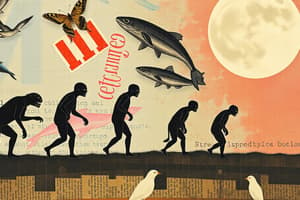Podcast
Questions and Answers
What is the process by which a species becomes better suited to its environment?
What is the process by which a species becomes better suited to its environment?
- Ecological niche formation
- Species adaptation (correct)
- Evolutionary development
- Community succession
What is the realized niche?
What is the realized niche?
- The unique role of a species in its environment
- The physical environment of a species
- The actual niche occupied by a species (correct)
- The full range of possible niches
What is the term for the process of change in species composition and structure of a biological community over time?
What is the term for the process of change in species composition and structure of a biological community over time?
- Community succession (correct)
- Species adaptation
- Ecological niche formation
- Evolutionary development
What is the primary goal of biodiversity conservation?
What is the primary goal of biodiversity conservation?
What is an example of a mechanism of species adaptation?
What is an example of a mechanism of species adaptation?
What is the term for the exchange of genes between populations?
What is the term for the exchange of genes between populations?
What is the climax community in community succession?
What is the climax community in community succession?
What is a threat to biodiversity?
What is a threat to biodiversity?
Study Notes
Ecosystem Evolution and Development
Species Adaptation
- Definition: The process by which a species becomes better suited to its environment, leading to increased survival and reproductive success.
- Mechanisms:
- Natural selection: favors individuals with beneficial traits.
- Genetic drift: random events alter gene frequencies.
- Gene flow: exchange of genes between populations.
- Examples:
- Antibiotic resistance in bacteria.
- Peppered moths adapting to industrial pollution.
Ecological Niche
- Definition: The unique role and position of a species within its environment, including its resources, habitat, and interactions.
- Components:
- Resource use: food, water, shelter, etc.
- Habitat use: physical environment, climate, etc.
- Interactions: predation, competition, symbiosis, etc.
- Types:
- Fundamental niche: the full range of possible niches.
- Realized niche: the actual niche occupied by a species.
Community Succession
- Definition: The process of change in species composition and structure of a biological community over time.
- Types:
- Primary succession: in newly formed habitats (e.g., volcanic islands).
- Secondary succession: in disturbed or altered habitats (e.g., after a forest fire).
- Stages:
- Pioneer species colonization.
- Intermediate stages: competition and species replacement.
- Climax community: stable, mature community.
Biodiversity Conservation
- Importance:
- Ecosystem services: pollination, pest control, climate regulation, etc.
- Human well-being: food security, medicine, recreation, etc.
- Threats:
- Habitat destruction and fragmentation.
- Climate change.
- Overexploitation of resources.
- Strategies:
- Protected areas: national parks, wildlife reserves, etc.
- Sustainable land-use planning.
- Restoration ecology: rehabilitating degraded habitats.
Species Adaptation
- Species adaptation is the process by which a species becomes better suited to its environment, leading to increased survival and reproductive success.
- Mechanisms of adaptation include:
- Natural selection, which favors individuals with beneficial traits
- Genetic drift, which involves random events that alter gene frequencies
- Gene flow, which is the exchange of genes between populations
- Examples of adaptation include:
- Antibiotic resistance in bacteria
- Peppered moths adapting to industrial pollution
Ecological Niche
- Ecological niche is the unique role and position of a species within its environment, including its resources, habitat, and interactions
- Components of an ecological niche include:
- Resource use (food, water, shelter, etc.)
- Habitat use (physical environment, climate, etc.)
- Interactions (predation, competition, symbiosis, etc.)
- Types of ecological niches include:
- Fundamental niche, which is the full range of possible niches
- Realized niche, which is the actual niche occupied by a species
Community Succession
- Community succession is the process of change in species composition and structure of a biological community over time
- Types of succession include:
- Primary succession, which occurs in newly formed habitats (e.g., volcanic islands)
- Secondary succession, which occurs in disturbed or altered habitats (e.g., after a forest fire)
- Stages of succession include:
- Pioneer species colonization
- Intermediate stages, characterized by competition and species replacement
- Climax community, which is a stable, mature community
Biodiversity Conservation
- Importance of biodiversity conservation includes:
- Ecosystem services (pollination, pest control, climate regulation, etc.)
- Human well-being (food security, medicine, recreation, etc.)
- Threats to biodiversity include:
- Habitat destruction and fragmentation
- Climate change
- Overexploitation of resources
- Strategies for biodiversity conservation include:
- Protected areas (national parks, wildlife reserves, etc.)
- Sustainable land-use planning
- Restoration ecology, which involves rehabilitating degraded habitats
Studying That Suits You
Use AI to generate personalized quizzes and flashcards to suit your learning preferences.
Description
This quiz explores the mechanisms and examples of species adaptation, including natural selection, genetic drift, and gene flow, leading to evolutionary changes in species.




